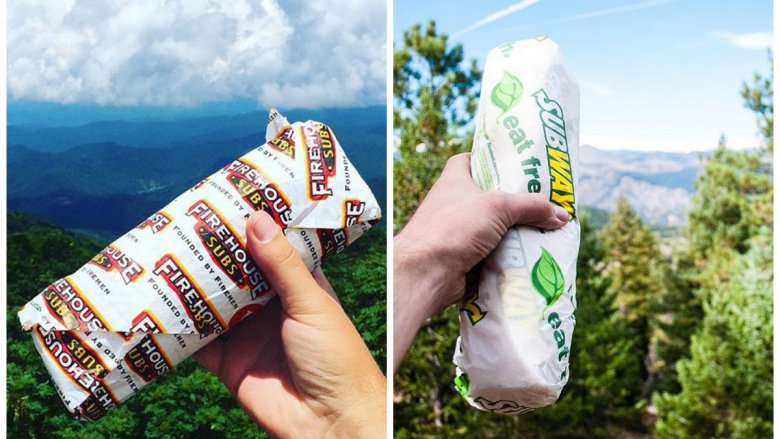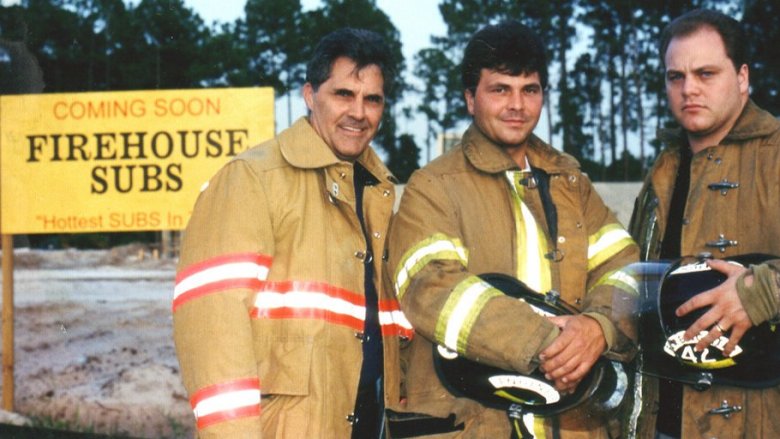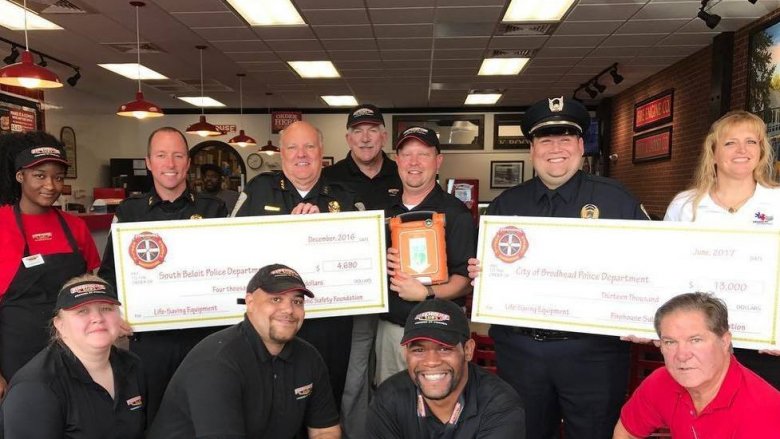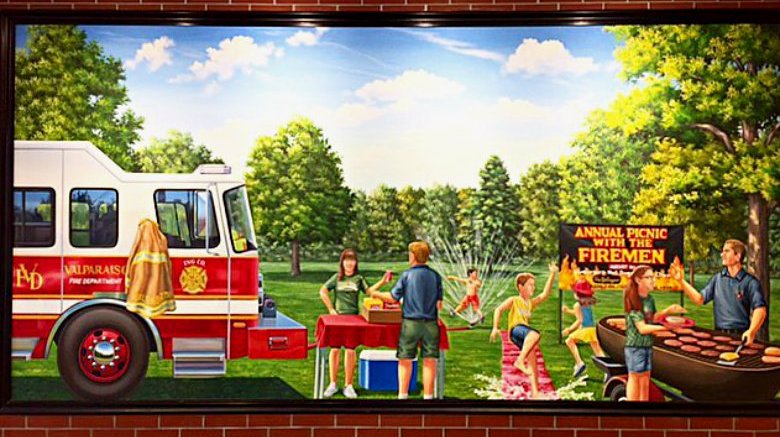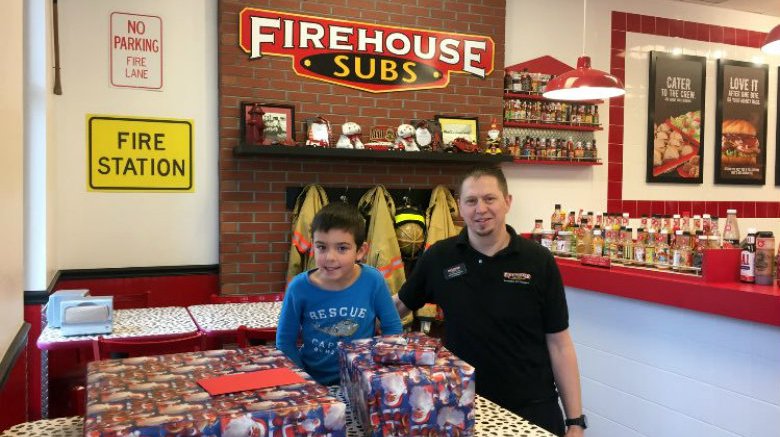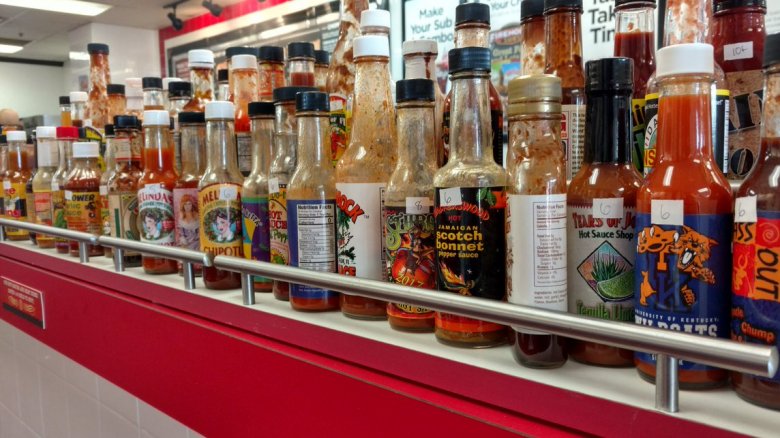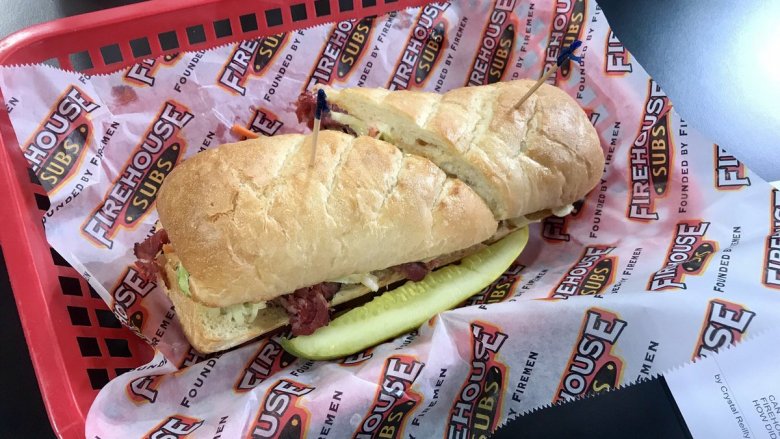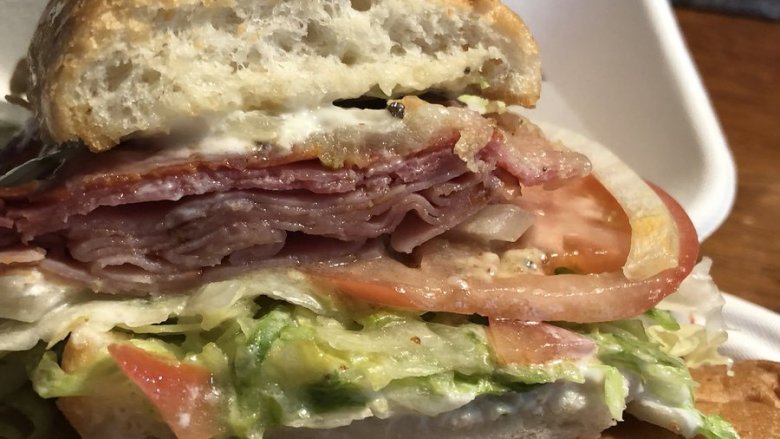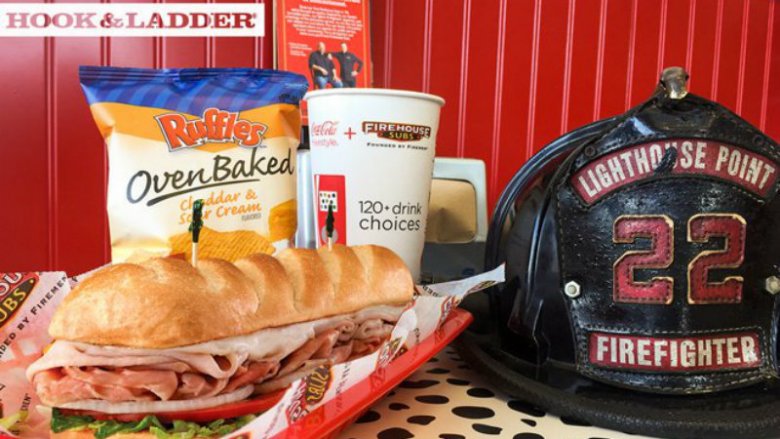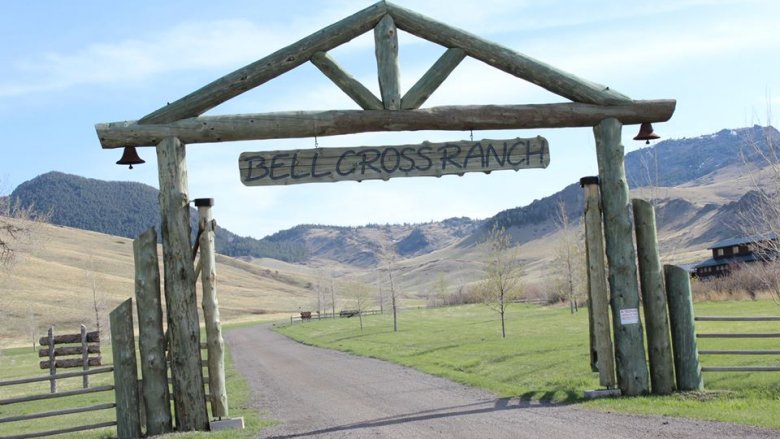Things You Didn't Know About Firehouse Subs
Either you're a loyal fan of the second most beloved sandwich chain in the country, or you've never heard of Firehouse Subs. Although the sandwich chain — best known for its fire station-themed decor and emphasis on hot sauces — is nowhere near the size or popularity of Subway, it received the second highest customer loyalty score of sandwich chains in America for 2018 (second only to Wawa).
What started as a simple sandwich shop in Florida has expanded to just over 1,100 stores around the nation, with a focus on toasted sandwiches piled high with meats and mayo, and an intimidating panel of hot sauces (ranked on a spicy scale from 1-10) at every store location.
We've rounded up a list of behind the scenes Firehouse Subs facts that anyone can appreciate, from the Firehouse superfan to the novice who has never eaten from the menu of kitschy fireman-themed sandwiches like the classic "Hook and Ladder."
Just call them the anti-Subway
We don't like comparing chains here, but Firehouse Subs has been dubbed by fans and Business Insider as the "anti-Subway." While that's not a dig at Subway's sandwich quality, the former chain markets their food as "fresh and healthy" options, while Firehouse Subs bypasses all of that nonsense and appears to focus almost exclusively on piling their hefty sandwiches high with meats, cheese, and homemade sauces, and feeding customers with big appetites. Unlike Subway, you won't find too many vegetables on a Firehouse sub.
In fact, even when the mid-sized chain finally began offering healthier options in 2014, they did not want to take away too much from their original formula, and instead began offering sandwiches with less bread and low-fat dressings and mayo to appease customers who were watching their diets. The founders boasted that even the under-500 calories sandwich menu has the exact same amount of meat (and protein) as its more indulgent counterparts.
They started with $100 in their pockets
The founders behind Firehouse Subs — two brothers who come from a family of firefighters — built their business from humble means. According to CNBC, Chris and Robin Sorensen only had $100 to their names when they first opened Firehouse Subs in Jacksonville, Florida in 1994. But the brothers believe that being broke led to the eventual success of their national sandwich chain.
"If we had the money — if we had opened up Firehouse when we first came up with the idea two years prior, we would've never made it," Robin Sorensen said in a 2016 interview. "Even though I didn't understand it at the time, being broke forced us to be patient, and that patience really turned out to be a service. We were able to learn a lot more about the business and grow at the right pace."
Even when Firehouse Subs started becoming popular and spreading, it wasn't until several years into their venture that they became profitable.
Hurricane Katrina inspired them
You may already know that Firehouse Subs is different than other quick service chains because of the brand's ties to community involvement. But you may not know that the Hurricane Katrina disaster in 2005 inspired the sandwich chain to start giving back to communities. After the hurricane struck, the Sorensen brothers donated equipment to help first responders in Mississippi.
From then, the feel-good notion of making their chain more than just about feeding people with an affinity for super-stuffed sandwiches stuck. This notion turned into the Firehouse Subs Public Safety Foundation, which as of early 2018, has raised $33 million to help benefit first responders in 43 states and Puerto Rico, from giving grants to donating lifeboats and other expensive, modern equipment that smaller firehouses might not otherwise be able to afford.
In March 2018, for instance, the Public Safety Foundation donated grants to help support the ongoing cleanup efforts for victims of Hurricane Maria in Puerto Rico.
The murals are all unique
Whether or not you're a fan of the elaborate firefighter-themed murals found on the inside of every Firehouse Subs location, they don't just exist to go with the first responder theme. Every mural in each of the Firehouse Subs locations is a unique homage to the firehouse in the local community. Local fire departments get a say in what the mural looks like, and some even donate old photos and equipment to the restaurant to really spruce up the place.
Surprisingly, every single mural in each of the Firehouse Subs restaurants has been painted by the same artist: Joe Puskas. Puskas starts each custom mural as a pencil sketch and then he and his team paint the murals, which always feature a fire truck that's unique to that particular city or town, as well as some personalized details like the town's fire dog. According to Foodbeast, the whole process can take up to 70 hours to complete.
They do a lot on the down-low
The Public Safety Foundation is not the only way Firehouse Subs gives back to their community. A lot of the charitable contributions are done on the down-low. Firehouse Subs franchisees have been quietly feeding first responders during the holidays since 2006. The heartwarming efforts began with a simple meal served to first responders on duty during Christmas in Mobile, Alabama, and since then the movement has grown to other Firehouse franchises, according to Money Inc.
The idea — Jim Sherman, owner of Firehouse franchises in Mobile, Alabama told Small Business Trends, came from his daughter:
"I used to be in the Coast Guard and had duty on Christmas Eve and Christmas Day," Sherman said. "Luckily, most of the time we had a galley that would feed us but in a couple of places, we didn't have that. So bringing food to those people during the holidays is something that's near and dear to me."
They have a hot sauce challenge
Anyone who has been to a Firehouse Subs restaurant knows that it's a haven for hot sauce junkies. When you order a sandwich, you can top it with any number of hot sauces (the sauces available vary, depending on your location) ranked from 1 to 10, or "barely there" to "melt your face off." A bunch of YouTube videos are out there with spice novices and experts trying the Firehouse Subs hot sauce challenge, where they douse they sample the level 10 hot sauce.
Firehouse Subs got wind of the hot sauce challenge and in 2015, posted a video of their ultimate "Level 55" hot sauce challenge, where they challenged customers to try each of the levels of hot sauce, from 1-10 on their sandwich. This adds up to – you guessed it — 55, and a whole lot of tongue pain (we assume). This challenge seems like it's more about pushing your limits than actually enjoying a sandwich, because who would want to dump 10 different types of sauce of their food?
They cherry-pick ingredients
When we think of where fast food and fast casual chains get their ingredients from, we probably picture factory farms and giant suppliers that churn out ingredients for a ton of chains. But for many of the ingredients you would find in a Firehouse Sub, Chris and Robin Sorensen have handpicked the distributors themselves.
For example, New Yorkers might think that the kosher dill pickle that comes on the side of the sandwiches tastes really familiar. That's because Firehouse gets its pickles from Katz's Deli in New York City, according to The Daily Meal. The bread, meanwhile, is sourced from a French bakery in Atlanta. The 16-hour smoked brisket comes from Saddler's Smokehouse in Texas, and so on and so forth.
As for the hot sauces, although those come from hot sauce companies from around the country, the in-house speciality hot sauce is called Captain Sorensen's Datil Pepper Hot Sauce and is named after the brothers' father, Captain Robert Sorensen.
The founders are obsessed with mayo
If you hate mayonnaise, we don't recommend visiting a Firehouse Subs (although, we suppose you can always ask for a sandwich minus the mayo). Most of the subs are served by default "fully involved" (another kitschy firehouse reference), which means it's automatically topped with a whole bunch of stuff, including lettuce, tomato, mustard, and a generous helping of mayo. The Sorensen Brothers believe that mayo is the "glue" that holds their sandwiches together.
"In the South, we put mayonnaise on everything, so it wasn't anything we even discussed," Robin Sorensen told Thrillist. "You put mayonnaise on a sandwich. The comment on pastrami from delis in New York is that's unheard of, it's mustard only. I like that, too. But all that drove us was our own personal tastes."
The mayonnaise used on the sandwiches is in fact Duke's mayonnaise, which any Southerner would immediately recognize as the favorite spread of Dixieland.
You can make the Hook & Ladder from home
One of the most popular sandwiches on the menu at Firehouse Subs is the Hook & Ladder. This pretty basic sandwich is topped with smoked turkey breast, honey ham, melted Monterey Jack cheese, and like most of the sandwiches, is served "fully involved." But if you don't have the time or funds to head to a Firehouse Subs yourself (or you don't have any locations by you), you can still make a homemade Hook & Ladder sandwich, thanks to this copycat recipe from Genius Kitchen.
The recipe emphasizes the importance of toasting the sub rolls, smoking the turkey breast, and using a whopping 1 ½ tablespoons (!!) of mayonnaise in the sandwich. The recipe also suggests mixing the mustard and mayo together to avoid a gloppy mess. The recipe author also suggested buying honey-glazed ham to avoid having to glaze the yourself.
They're ranchers, too
So, where do the founders and owners of the Firehouse Subs sandwich chain like to relax when they're not testing out face-melting hot sauces or giving away fire equipment to local communities? They come to the Sorensen family ranch (known as Bell Cross Ranch) in Cascade, Montana (with a population of under 1,000). The sprawling 9,000-acre ranch in Big Sky Country, dotted with cattle, horses, and other wildlife represents the "home-down country boy" roots of the Sorensen family, and really looks like the Wild, Wild West.
The family regularly hosts guests and media to try horseback riding, hiking, campfire grilling, and mounted shooting: also known to cityslickers as "roughing it." The brothers regularly visit their ranch (probably for some divine carnivorous inspiration), and help the surrounding communities. In fact, the Cascade County fire station was the recipient of a fire boat worth $38,000 in 2014, according to Vie Magazine.
